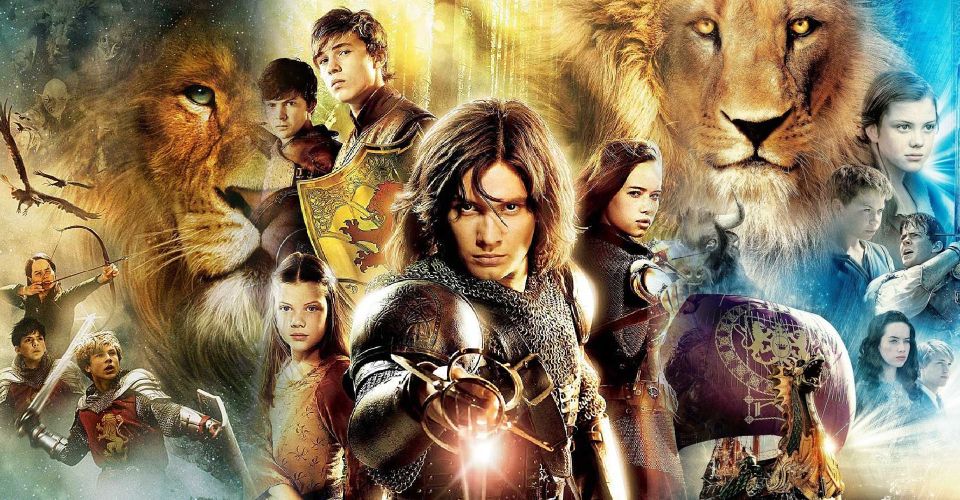Chronicles of Narnia Timeline Explained: When Each Movie Takes Place

The timeline of The Chronicles of Narnia movies can be a bit confusing, especially because it’s really two timelines: the story of Narnia, and the story of Earth. After all, Narnia is in many ways a story about escape. It’s about four kids struggling to hold onto their childhood in the middle of a war and the fantastical place that lets them be something more than scared. But how long exactly do they escape for? How does the Narnia timeline work in the movies? And how does it tie back to the Pevensies’ story and personal growth when they’re back in the human world?
The exact nature of Narnia is, naturally, unclear, but the books give a bit more insight. In The Magician’s Nephew, C.S. Lewis’s prequel novel to The Lion, the Witch and the Wardrobe, the author drops a few hints. The book tells the story of Digory Kirke (the boy who would become the owner of the titular wardrobe) and his friend Polly, who use magic rings to access a transdimensional nexus called “The Wood Between the Worlds.” The Wood is full of pools that act as portals to other realms, one of which is the yet-to-be-born world of Narnia. The Magician’s Nephew then shows Aslan create Narnia out of nothing.
The real-world parts of The Magician’s Nephew are set in 1900, 40 years before the events of The Lion, the Witch and the Wardrobe. However, a span of 1000 years passes during that same time in Narnia. In the books, the Narnia story covers the entire life of the world, with The Last Battle detailing the end of the magical world some 2500 years after its creation by Aslan. In the real world, that same time only covers 50 years.
Of course, transitioning fantasy from page to screen can mean some changes, so what about the films? The first three books – The Lion, the Witch and the Wardrobe, Prince Caspian, and The Voyage of the Dawn Treader – were all adapted by Walden Media during the early 2000s, and their specific portion of the saga’s timeline can be a bit confusing. So without further ado, here’s when each film takes place in Narnia time, real-world time, and how they relate to one another.
The Lion, the Witch and the Wardrobe

The Lion, the Witch and the Wardrobe takes place in England in 1940, in the midst of the London Blitz. Lucy, Edmund, Susan, and Peter Pevensie are sent out of the city to stay with Professor Digory Kirke in the country, in order to keep them safe during the bombings. While there, Lucy accidentally makes her first voyage into Narnia through the magical wardrobe, which Digory had built using wood from a Narnian tree.
When Lucy first enters Narnia, it has been a thousand years since the fantasy world’s creation and a hundred years since the White Witch plunged the realm into eternal winter. Since Narnia was created in 1900, this first time jump means Narnia is moving about 25 times faster than the real world (though that pace is inconsistent). The lamppost located near the entrance of the wardrobe is a clue to this, as it is later revealed to have accidentally been brought into Narnia in The Magician’s Nephew while Aslan was setting the world in motion.
The Pevensies then spend 15 years living in Narnia, ruling as its kings and queens. The Horse and His Boy, the series’ fifth book, takes place during this time and follows the adventures of a Narnia-born boy named Shasta. However, when the siblings find their way back to the lamppost and transfer to their world, only a moment has past.
Prince Caspian

The second film takes place just one year after the first in the real world, but nearly 1300 years later in Narnia, putting the events of Prince Caspian about 2300 years after the creation of the realm. The story takes place over just a brief period of time, and the Pevensies are all returned home promptly after Caspian takes the throne. In the real world, only seconds pass between when the children are summoned to Narnia by Caspian and when they are sent back. It’s the kind of dilation you’d expect to see in a Christopher Nolan movie.
The huge discrepancy between the real-world time and Narnia time from the first movie to the second shows that, really, there is no consistency between the two worlds’ timelines. More Narnia time passes in a year on Earth than in the 40 years prior, suggesting the worlds are completely independent and only tied together vaguely by the ability of some people to be temporarily brought from one world to the other and back.
While barely any Narnia time passes over the course of the film, it is a significant period for the narrative. Specifically, it marks the transition for Susan and Peter from childhood to adulthood and therefore their last visit to Narnia before the world’s end. The land of Narnia is tied directly to the idea and experiences of childhood, so when the children grow out of childhood, they grow out of Narnia as well.
The Voyage of the Dawn Treader

One year later on Earth (setting the story in 1942), Lucy, Edmund, and their cousin Eustace enter Narnia and are reunited with Caspian (now king), Reepicheep the mouse, and the rest of the crew of the Dawn Treader. In Narnia, only a few years have passed since the events of the second film. Like before, the children are returned home at the end with no real time having passed. Edmund and Lucy are informed by Aslan (as Peter and Susan are at the end of Prince Caspian) that they are grown up now and therefore can no longer return to Narnia, while Eustace is told he may return one day.
While the film series ended with The Voyage of the Dawn Treader, the books continue to tell the stories of Narnia for about two hundred and fifty years more, at which point the realm is ended during The Last Battle. The final book takes place in 1949, meaning the last time jump is about seven years human-time to 250 years Narnia-time. The series culminates in a wild chain of apocalyptic events and the shocking death of the core Earth characters (minus Susan) in a train accident. These characters then join Aslan and the people of Narnia in a Heaven stand-in. It’s an ending that’s both odd, dark, poetic, and Biblical. Ultimately, the life and death of the world shown in The Chronicles of Narnia – 2500 years – takes less than 50 years on Earth.
About The Author


















